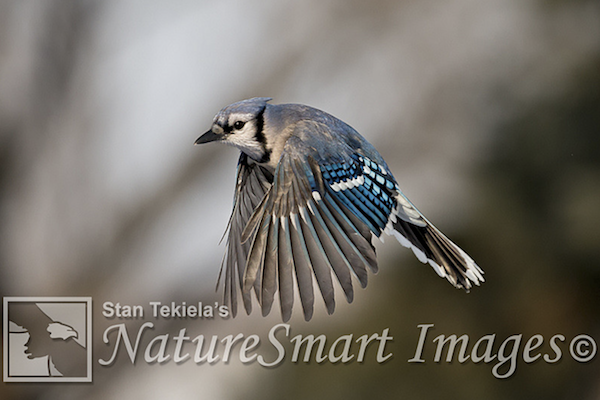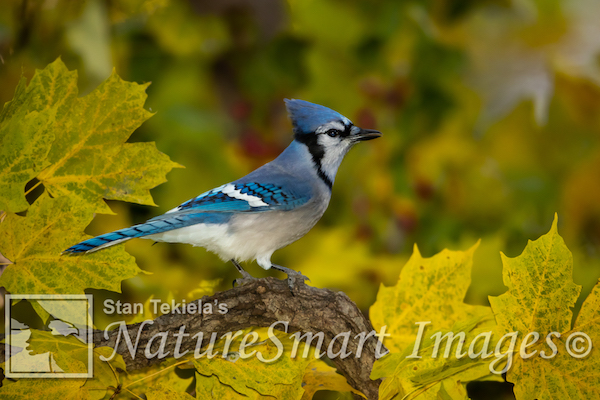
A Blue Jay Picture Worth Waiting For
Wildlife photographer and naturalist Stan Tekiela takes us on an outing to capture the beauty of a blue jay.

I’d been waiting and planning to capture a very specific image for over three weeks. I put a fair amount of time and effort into making sure that everything would work out.
The time had come. The leaves on the sugar maples had changed from the shiny green of summer to the bright yellow of autumn. I set up my longest lens—a gigantic and heavy 800 mm one—on my most sturdy tripod. (Stability is of utmost importance for this kind of photography.) I attached a speed light (flash) with an extra device that magnifies and concentrates the light from the flash into a powerful beam of light.
I mounted my best camera on the long lens and got ready. The cool autumn morning broke with a thin layer of clouds, blocking just enough sun to make for perfect lighting conditions. It was a waiting game now.
I love autumn. I enjoy just sitting back and watching nature do its thing. While waiting for blue jays to appear, I watched an Eastern gray squirrel scampering about, pushing its nose deep under the layer of newly fallen leaves, searching for acorns that had landed there nearly 2 months before. He would pop up his head, acorn in hand, and start to eat.
I could see a newly arrived dark-eyed junco scratching around under my bird feeder. They do a special backwards, double-foot hop to expose any hidden seeds on the ground. These birds live up in Canada and come down to visit us only for the winter. You know winter is on the way when you start to see the juncos. The females migrate farther south than the males, so we usually end up with only males hanging around for the winter.
Off in the distance, I could hear a flock of Canada geese calling on the wing. No doubt they were heading south for a warmer climate.
There was a constant “rain” of bright yellow leaves falling from the towering maple trees above me. Several leaves landed in my lap and brushed against me on their descent. They spent the entire summer 60 to 80 feet up in the trees. They saw gentle spring rains and summer storms that blew strong winds. They saw lightning and hail, and now they are dying, losing their attachment to the tree and silently falling to earth.
Not too far away, I could hear the familiar call of the bird I was waiting for. I activated my camera and turned on my flash. I needed to be ready because I would only have a split second to capture the image I had envisioned in my head. The call came closer. I gripped the camera with my right hand and held onto the adjustment knobs of the tripod with my left hand. Slowly, I moved my eye closer to the camera’s view finder so I would be ready and could avoid any sudden movements when it came time to capture the image.
Two birds landed in the branches above me. I held my breath. Here it was, the very reason I was here, to capture a perfect picture of a blue jay. The blue jays gave several more calls, loudly announcing their presence. All the other birds seemed to take note of the blue jays and scatter.
I waited, almost willing the jays with my mind to approach close enough to my camera. Suddenly, one blue jay jumped from its high branch and landed at eye level. I quickly looked though the view finder of the camera and adjusted the focusing dot. (It is extremely important that the eye of the bird is in focus, not just the body of the bird.)

Blue jay in fall colors, taken in southern Minnesota
I spun the dials around on the top and back of the camera at the same time. Quickly, I captured a couple of images. The flash went off, adding just the touch of light needed to make the colors pop. The blue jay didn’t even notice me or the camera. I checked the preview screen on the back of my camera to see if the exposure was correct and if the bird looked good. I got it! Weeks of preparation paid off beautifully.
If you enjoyed Stan’s blue jay post, you may consider one of his amazing nature books: Majestic Eagles; The Lives of Wolves, Coyotes, and Foxes; or Backyard Birds: Welcomed Guests at our Gardens and Feeders. Young readers will delight in his award-winning children’s books, such as Whose Butt?, Critter Litter, and his latest, Jump, Little Wood Ducks.
You can follow Stan on Facebook and Twitter, or contact him via his web page. Stan’s nationally syndicated NatureSmart Column appears in more than 25 cities spanning 5 states (Minnesota, Wisconsin, Michigan, Illinois, and Pennsylvania) and is circulated to more than 750,000 readers. Stan’s author page on Amazon features some amazing videos! Check them out, and follow him for updates.
For more stories about wildlife and nature, sign up for our newsletter now!
More posts from Stan:
Indigo Bunting—A Familiar Summer Visitor
The Nesting Behaviors of Sandhill Cranes
Big Birds, Baby Birds, Birds Everywhere
Stan Tekiela observes Marsh Wrens
The Magical, Mystical World of Sandhill Cranes


